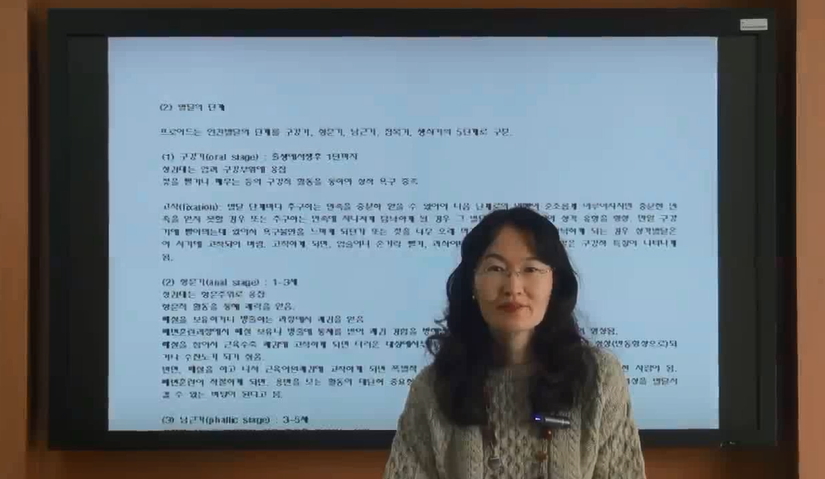This essay is an examination of the way in which the Oedipus complex, which is traditionally regarded as the centerpiece of Freudian theory, is reinterpreted by Jacques Lacan in the light of what he calls the ‘formulas of metaphor’ or the signif...
http://chineseinput.net/에서 pinyin(병음)방식으로 중국어를 변환할 수 있습니다.
변환된 중국어를 복사하여 사용하시면 됩니다.
- 中文 을 입력하시려면 zhongwen을 입력하시고 space를누르시면됩니다.
- 北京 을 입력하시려면 beijing을 입력하시고 space를 누르시면 됩니다.
부가정보
다국어 초록 (Multilingual Abstract)
Freudian theory of the Oedipus Complex, which is concerned with such critical issues as the formation of the human subject, the logic of affects, and the question of sexual difference, tends to be articulated largely in terms of the real family structure, as is manifested in his phrase ‘family romance.’
On the other hand, Lacanian approach to the Oedipal structure is mainly structural and linguistic, with the paternal signifier ‘Name-of-the-Father’ substituted for the ‘Desire of the Mother’ resulting in the structure of the ‘Name-of-the-Father’ (Other/Phallus). Otherwise said, the overcoming of the Oedipal conflict means in Lacanian terms a successful accession to the symbolic order or the big Other (O), set of signifiers and a birth of the human subject with sexual identity, securing a phallic meaning (Ф).
According to Lacan, the difference between the mother and the father, even when it is sexually marked, cannot be ‘translated’ into the difference between the man and the woman. Every attempt at such symbolic translation leaves a ‘surplus-effect,’ which is the real of sexual difference.
The last part of the essay is devoted to the way in which the human subject is differently positioned with respect to the Other. This different subject position vis-?-vis the Other explains what Lacan calls ‘sexuation’ and the Other jouissance as distinguished from the phallic jouissance.
This essay is an examination of the way in which the Oedipus complex, which is traditionally regarded as the centerpiece of Freudian theory, is reinterpreted by Jacques Lacan in the light of what he calls the ‘formulas of metaphor’ or the signifying substitution.
Freudian theory of the Oedipus Complex, which is concerned with such critical issues as the formation of the human subject, the logic of affects, and the question of sexual difference, tends to be articulated largely in terms of the real family structure, as is manifested in his phrase ‘family romance.’
On the other hand, Lacanian approach to the Oedipal structure is mainly structural and linguistic, with the paternal signifier ‘Name-of-the-Father’ substituted for the ‘Desire of the Mother’ resulting in the structure of the ‘Name-of-the-Father’ (Other/Phallus). Otherwise said, the overcoming of the Oedipal conflict means in Lacanian terms a successful accession to the symbolic order or the big Other (O), set of signifiers and a birth of the human subject with sexual identity, securing a phallic meaning (Ф).
According to Lacan, the difference between the mother and the father, even when it is sexually marked, cannot be ‘translated’ into the difference between the man and the woman. Every attempt at such symbolic translation leaves a ‘surplus-effect,’ which is the real of sexual difference.
The last part of the essay is devoted to the way in which the human subject is differently positioned with respect to the Other. This different subject position vis-?-vis the Other explains what Lacan calls ‘sexuation’ and the Other jouissance as distinguished from the phallic jouissance.
목차 (Table of Contents)
- Ⅰ. 오이디푸스 콤플렉스
- Ⅱ. ‘아버지의 이름’의 메타포
- Ⅲ. 팰러스: 성적 주체성
- 인용문헌
- Abstract
- Ⅰ. 오이디푸스 콤플렉스
- Ⅱ. ‘아버지의 이름’의 메타포
- Ⅲ. 팰러스: 성적 주체성
- 인용문헌
- Abstract
참고문헌 (Reference)
1 "라캉: 재현과 그 불만" 서울: 문학과 지성사 2006
2 "The Standard Edition of the Complete Psychological Works of Sigmund Freud" 24 s : 1953-74
3 "The Seminar of Jacques Lacan XX the Limits of Love and Knowledge" 1972-731998
4 "The Lacanian Subject: Between Language and Jouissance" Princeton: Princeton UP 1995
5 "The Four Fundamental Concepts of Psychoanalysis" 1977
6 "Lacanian Theory of Discourse" 1994
7 "Lacan's Major Work on Love" Albany: SUNY P 2002
8 "Lacan and Philosophy" The Cambridge Companion to Lacan" Cambridge: Cambridge UP 2003
9 "Key Concepts of Lacanian Psychoanalysis" New York: Other P 1998
10 "From Freud to Lacan Newsletter of the Freudian Field" 30-50, 1989
1 "라캉: 재현과 그 불만" 서울: 문학과 지성사 2006
2 "The Standard Edition of the Complete Psychological Works of Sigmund Freud" 24 s : 1953-74
3 "The Seminar of Jacques Lacan XX the Limits of Love and Knowledge" 1972-731998
4 "The Lacanian Subject: Between Language and Jouissance" Princeton: Princeton UP 1995
5 "The Four Fundamental Concepts of Psychoanalysis" 1977
6 "Lacanian Theory of Discourse" 1994
7 "Lacan's Major Work on Love" Albany: SUNY P 2002
8 "Lacan and Philosophy" The Cambridge Companion to Lacan" Cambridge: Cambridge UP 2003
9 "Key Concepts of Lacanian Psychoanalysis" New York: Other P 1998
10 "From Freud to Lacan Newsletter of the Freudian Field" 30-50, 1989
동일학술지(권/호) 다른 논문
-
이미지의 실재성 - 들뢰즈의 『시네마1: 운동-이미지』를 중심으로
- 한국비평이론학회
- 김지영(Kim Jiyoung)
- 2007
- KCI등재
-
텍스트의 세속성과 정치성 - Said, Jameson, Eagleton을 중심으로
- 한국비평이론학회
- 오길영(Gilyoung Oh)
- 2007
- KCI등재
-
- 한국비평이론학회
- 김준환(Joon-Hwan Kim)
- 2007
- KCI등재
-
The Holocaust, Narrative, and Mourning
- 한국비평이론학회
- Kyeong Hwangbo(황보경)
- 2007
- KCI등재
분석정보
인용정보 인용지수 설명보기
학술지 이력
| 연월일 | 이력구분 | 이력상세 | 등재구분 |
|---|---|---|---|
| 2027 | 평가예정 | 재인증평가 신청대상 (재인증) | |
| 2021-01-01 | 평가 | 등재학술지 유지 (재인증) |  |
| 2018-01-01 | 평가 | 등재학술지 유지 (등재유지) |  |
| 2015-01-01 | 평가 | 등재학술지 유지 (등재유지) |  |
| 2011-01-01 | 평가 | 등재 1차 FAIL (등재유지) |  |
| 2009-01-01 | 평가 | 등재학술지 유지 (등재유지) |  |
| 2006-01-01 | 평가 | 등재학술지 선정 (등재후보2차) |  |
| 2005-05-30 | 학회명변경 | 영문명 : The Criticism And Theory Society Of Korea -> The Criticism and Theory Society of Korea |  |
| 2005-01-01 | 평가 | 등재후보 1차 PASS (등재후보1차) |  |
| 2004-11-28 | 학술지등록 | 한글명 : 비평과이론외국어명 : The Journal of Criticism and Theory |  |
| 2004-01-01 | 평가 | 등재후보 1차 FAIL (등재후보1차) |  |
| 2003-01-01 | 평가 | 등재후보학술지 선정 (신규평가) |  |
학술지 인용정보
| 기준연도 | WOS-KCI 통합IF(2년) | KCIF(2년) | KCIF(3년) |
|---|---|---|---|
| 2016 | 0.69 | 0.69 | 0.51 |
| KCIF(4년) | KCIF(5년) | 중심성지수(3년) | 즉시성지수 |
| 0.43 | 0.36 | 1.442 | 0.13 |




 스콜라
스콜라




